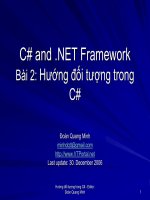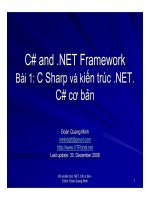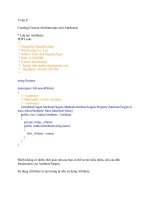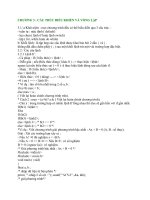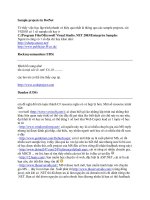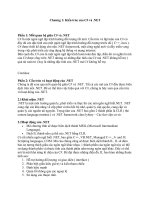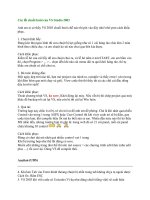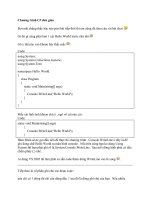Tài liệu C++ Coding Standard Specification doc
Bạn đang xem bản rút gọn của tài liệu. Xem và tải ngay bản đầy đủ của tài liệu tại đây (541.56 KB, 60 trang )
Project Support Team - IT Division
C++ Coding Standard
Specification
Version: 1.1
Issue: 5
Status: FINAL
ID: CERN-UCO/1999/207
Date: 5 January 2000
European Laboratory for Particle Physics
Laboratoire Européen pour la Physique des Particules
CH-1211 Genève 23 - Suisse
C++ Coding Standard Specification
5 January 2000 Version/Issue: 1.1/5
page ii FINAL
This document has been prepared using the Software Documentation Layout Templates that have been
prepared by the IPT Group (Information, Process and Technology), IT Division, CERN (The European
Laboratory for Particle Physics). For more information please contact
FINAL page iii
C++ Coding Standard Specification
Abstract Version/Issue: 1.1/5
Abstract
This document defines a C++ coding standard, that should be adhered to when writing C++
code. It is the result of a work started in a Working Group, in the context of the SPIDER
project, formed by representatives from different LHC experiments, with the goal to bring
together their existing coding standards.
Document Control Sheet
Table 1 Document Control Sheet
Document Title:
C++ Coding Standard Specification
Version:
1.1
ID:
CERN-UCO/1999/207
Issue:
5
Status:
FINAL
Edition:
[Document Edition]
Created:
Date:
5 January 2000
Available at:
/>Keywords:
coding standard, C++
Tool Name:
Adobe FrameMaker
Version:
5.5
Template:
Software Doc Layout Templates
Version:
Vb1
Authorship Written by:
S.Paoli
Contributors:
P.Binko (LHCb), D.Burckhart (ATLAS), S.M.Fisher (ATLAS), I.Hriv-
nacova (ALICE), M.Lamanna (COMPASS), M.Stavrianakou (ATLAS),
H P.Wellisch (CMS)
Reviewed by:
S.Giani, A.Khodabandeh
Approved by:
G.H.Pawlitzek
C++ Coding Standard Specification
Document Status Sheet Version/Issue: 1.1/5
page iv FINAL
Document Status Sheet
Table 2 Document Status Sheet
Title:
C++ Coding Standard Specification
ID: CERN-UCO/1999/207
Version Issue Date Reason for change
1.0 0 5.3.1999 Release to the Review Board for review
1.1 1 4.8.1999 First public release
1.1 2 13.8.1999 Changed the item identifiers in paragraph 3.8
1.1 3 17.8.1999 Corrected title of item CB1
1.1 4 20.10.1999 Added CERN write-up reference on the front page
1.1 5 5.1.2000 Added missing “int” in item CA5.
Changed SPIDER to Project Support Team. New e-mail address:
FINAL page v
C++ Coding Standard Specification
Table of Contents Version/Issue: 1.1/5
Table of Contents
Abstract . . . . . . . . . . . . . . . . . . . . . . . . . . . . . iii
Document Control Sheet. . . . . . . . . . . . . . . . . . . . . . . . iii
Document Status Sheet . . . . . . . . . . . . . . . . . . . . . . . . iv
Table of Contents . . . . . . . . . . . . . . . . . . . . . . . . . . v
1 Introduction . . . . . . . . . . . . . . . . . . . . . . . . . . . 1
1.1 Purpose . . . . . . . . . . . . . . . . . . . . . . . . . . .1
1.2 Intended Audience . . . . . . . . . . . . . . . . . . . . . . .1
1.3 Authors . . . . . . . . . . . . . . . . . . . . . . . . . . .1
1.4 Evolution and updating responsibility . . . . . . . . . . . . . . . .2
1.5 Approach . . . . . . . . . . . . . . . . . . . . . . . . . .2
1.5.1 Naming . . . . . . . . . . . . . . . . . . . . . . . . .3
1.5.2 Coding . . . . . . . . . . . . . . . . . . . . . . . . .3
1.5.3 Style . . . . . . . . . . . . . . . . . . . . . . . . . .3
1.5.4 Information provided for the items . . . . . . . . . . . . . . .3
1.6 Organization of this document . . . . . . . . . . . . . . . . . . .4
1.7 References . . . . . . . . . . . . . . . . . . . . . . . . . .4
1.8 Definitions and Acronyms . . . . . . . . . . . . . . . . . . . .5
2 Naming . . . . . . . . . . . . . . . . . . . . . . . . . . . . . 7
2.1 Naming of files . . . . . . . . . . . . . . . . . . . . . . . .7
2.2 Meaningful Names . . . . . . . . . . . . . . . . . . . . . . .8
2.3 Illegal Naming . . . . . . . . . . . . . . . . . . . . . . . .8
2.4 Naming Conventions . . . . . . . . . . . . . . . . . . . . . .9
3 Coding . . . . . . . . . . . . . . . . . . . . . . . . . . . . . 13
3.1 Organizing the Code . . . . . . . . . . . . . . . . . . . . . 13
3.2 Control Flow . . . . . . . . . . . . . . . . . . . . . . . . 15
3.3 Object Life Cycle . . . . . . . . . . . . . . . . . . . . . . . 16
3.3.1 Initialization of Variables and Constants . . . . . . . . . . . . 16
3.3.2 Constructor Initializer Lists . . . . . . . . . . . . . . . . . 18
3.3.3 Copying of Objects . . . . . . . . . . . . . . . . . . . . 19
3.4 Conversions . . . . . . . . . . . . . . . . . . . . . . . . 20
3.5 The Class Interface . . . . . . . . . . . . . . . . . . . . . . 20
3.5.1 Inline Functions . . . . . . . . . . . . . . . . . . . . . 21
3.5.2 Argument Passing and Return Values . . . . . . . . . . . . . 21
3.5.3 const Correctness . . . . . . . . . . . . . . . . . . . . 22
3.5.4 Overloading and Default Arguments . . . . . . . . . . . . . . 23
3.6 new and delete . . . . . . . . . . 23
C++ Coding Standard Specification
Table of Contents Version/Issue: 1.1/5
page vi FINAL
3.7 Static and Global Objects . . . . . . . . . . . . . . . . . . . . 24
3.8 Object-Oriented Programming . . . . . . . . . . . . . . . . . . 24
3.9 Assertions and error conditions . . . . . . . . . . . . . . . . . . 26
3.10 Error Handling . . . . . . . . . . . . . . . . . . . . . . . 27
3.11 Parts of C++ to Avoid . . . . . . . . . . . . . . . . . . . . . 28
3.12 Readability and maintainability . . . . . . . . . . . . . . . . . 31
3.13 Portability . . . . . . . . . . . . . . . . . . . . . . . . . 32
4 Style . . . . . . . . . . . . . . . . . . . . . . . . . . . . . . 35
4.1 General aspects of style . . . . . . . . . . . . . . . . . . . . 35
4.2 Comments . . . . . . . . . . . . . . . . . . . . . . . . . 37
A Terminology . . . . . . . . . . . . . . . . . . . . . . . . . . . 39
B List of the items of the standard . . . . . . . . . . . . . . . . . . . . 43
C Correspondence of item numbers. . . . . . . . . . . . . . . . . . . . 51
FINAL page 1
C++ Coding Standard Specification
1 Introduction Version/Issue: 1.1/5
1 Introduction
This chapter describes the approach adopted for the definition of this document.
1.1 Purpose
The purpose of this document is to define a C++ coding standard that should be adhered to
when writing C++ code. ISO 9000 and the Capability Maturity Model (CMM) state that
coding standards are mandatory for any organization with quality goals. The standard
provides indications aimed at helping C++ programmers to meet the following requirements
on a program:
• be free of common types of errors
• be maintainable by different programmers
• be portable to other operating systems
• be easy to read and understand
• have a consistent style
Questions of design, such as how to design a class or a class hierarchy, are beyond the scope of
this document. It is also assumed that the code is hand-written and not generated; otherwise a
different standard would be needed for the input to the code generator.
This document does not substitute in any way the study of a book on C++ programming. To
learn the C++ language we refer you to the classical books: [9] for getting started, and [10] for
a complete and definitive guide. For more advanced readings on C++, we strongly
recommend the books [11], [12] and [13].
1.2 Intended Audience
This document is addressed to all people involved in the production of C++ code for the
experiments/projects at CERN.
1.3 Authors
This document originated in the context of the SPIDER project, where during summer 1998 a
working group was set up, formed by representatives from different experiments/projects:
ALICE, ATLAS, LHCb, CMS and COMPASS, and led by the IT/IPT group. Its goal was to
propose a common standard across experiments/projects in order to foster common
solutions, homogeneity of the C++ code produced in different experiments/projects, and save
resources for implementation and maintenance of products and services (coding standard,
C++ Coding Standard Specification
1 Introduction Version/Issue: 1.1/5
page 2 FINAL
code check utilities, help-desk, tutorials, etc.). The work started from the C++ coding
standards that were already in place in the experiments/projects participating to the Working
Group [1], [2], [3], [4], [5]; the working group did an important work of identification of all the
commonalities, and subsequent clarification, consolidation and agreement of the items to
include in the common standard.
The work group was interrupted in spring 1999 by the suspension of the SPIDER project. The
definition of the standard was completed by the IT/IPT group, taking into account feedback
received from various experiments and individuals. Its audience was extended to all people
involved in the production of C++ code at CERN.
1.4 Evolution and updating responsibility
Changes to this standard will be implemented according to a change management procedure,
defined in the context of the Project Support Team, the follow up to the SPIDER project.
Feedbacks and suggestion on how to improve this document are encouraged; they should be
sent to
A continuation related to this standard was the evaluation of available static analysis tools, to
support automatic checking of code against this standard. This evaluation has been
performed; the detailed evaluation report is available from [6].
1.5 Approach
The sources of this standard are the original experiments/projects’ documents [1], [2], [3], [4],
[5], and the well known ELLEMTEL standard (last edition) [7], the de-facto C++ coding
standard in the software industry; also the famous book by S.Meyers [11] has provided useful
inputs for this standard. The present document contains, no more or different items (see par.
1.8) than those contained in the above mentioned documents. A selection and, in some cases, a
rewording of the items have been necessary in order to achieve a coherent and comprehensive
coding standard (set of items).
The experiments/projects’ standards [1], [2], [3], [4], [5] can be found on the web, while the
books [7] and [11] can be consulted in the Reference Section of the IPT library (CERN, Meyrin,
building 1 R-017).
In any case, the standard cannot cover every issue of C++ programming, and cannot always
match the different choices that different experiments/projects have made on certain issues.
Therefore the different experiments/projects should, if necessary, tailor this standard to their
specific quality requirements; this could mean to suppress an item or to add additional items.
The items contained in this standard have been organized in three sections: Naming, Coding
and Style. The content of each section is described below.
Though usually items in coding standards are characterized with different levels of
importance (rules and guidelines/recommendations), the items of this standard have not
FINAL page 3
C++ Coding Standard Specification
1 Introduction Version/Issue: 1.1/5
been characterized in this way. The reason is that the different experiments/projects have
different quality criteria, which determine whether a certain item is a “rule” or a “guideline”,
as well as different implications of the importance levels (how “rules” or “guidelines” are
differently enforced). Avoiding to propose such a characterization in this standard allows
experiments/projects to adopt their own criteria.
This approach causes one problem: it seems that all the defined items have the same level of
importance. The reader should be aware that some items are very important, as they strongly
impact the quality of the produced code. On the other hand, some items are rather arbitrary
conventions whose importance is simply in fostering a common style and idiom across a wide
community of programmers; the benefit is clearly an increase in the readability and
maintainability of the produced code.
1.5.1 Naming
This section contains indications on how to choose names for all entities over which the
programmer has control, e.g. classes, typedefs, functions, variables, namespaces, files.
1.5.2 Coding
Indications in this section regard the syntax and related semantic of the code. Organization of
code, control flow, object life cycle, conversions, object-oriented programming, error handling,
parts of C++ to avoid, portability, are all examples of issues that are covered here. This section
is organized in different paragraphs, each one grouping items addressing the same subject.
1.5.3 Style
Code is always written in a particular style. This section contains indications aimed at
defining one, that should allow a common and consistent look and feel of the code. Style
relates to matters which anyway do not affect the output of the compiler.
1.5.4 Information provided for the items
Each item comprises at least two entities, an identifier and an item title. The identifier is
formed by two letters and a number (e.g. NF3); the first letter (N, C or S) indicates to which
section (Naming, Coding or Style) the item belongs, the second letter indicates the subsection,
while the number simply represent the order within the subsection. This kind of identification
should allow a minimal impact on the items numbering during the maintenance of the
standard, that is in the possible cases in which items are added or removed.
Whenever possible and appropriate, a statement and an example have been added to the
individual item; the statement is an explanation that expands the item title and clarifies its
meaning and scope.
C++ Coding Standard Specification
1 Introduction Version/Issue: 1.1/5
page 4 FINAL
For most items two other keywords, source and status, are also present; this information was
maintained until version 0.8 of the document, that is as long as the document was defined in
the SPIDER working group. For the items subsequently introduced, and therefore not
discussed in the working group, the status information is not present. The meaning of the two
keywords is the following:
• Source: provides the identifier of the items from which the item was derived (See
Table 1)
• Status: indicates whether the item was agreed by all experiments/project in the
working group (Status = Common), or by the majority of them (Status = Majority)
The two keywords source and status are temporary; they will stay for the time necessary to
help a possible migration to this standard, but will be removed as soon as they become
historical information.
1.6 Organization of this document
This document is organized as follows:
• Chapter 1: Introduction - this chapter
• Chapter 2: Naming - list of all items on naming, with explanation and examples
• Chapter 3: Coding - list of all items on coding, with explanation and examples
• Chapter 4: Style - list of all items on style, with explanation and examples
• Appendix A: Terminology
• Appendix B: List of the items of the standard
• Appendix C: Correspondence of item numbers, from this version to version 0.8
1.7 References
1 C++ coding standards for ATLAS, S.M.Fisher, L.A.Tuura.
Document on the WWW at the URL:
/>Table 1 mapping between Identifier and the Source document
Identifier (n=number) Source document
n.RN (or RC, RS, GN, GC, GS) CMS
CXX-n ATLAS
Rn LHCb
COMPn COMPASS
ARNn ALICE
FINAL page 5
C++ Coding Standard Specification
1 Introduction Version/Issue: 1.1/5
2 C++ Coding Conventions, P.Binko. LHCb Computing Note: LHCb 98-049 COMP
3 The CMS coding and design guidelines, J.P.Wellisch.
CMS-NOTE 1998/070, CMS-NOTE 1998/071, and CMS-NOTE 1998/072
4 ALICE C++ Coding Conventions, I.Hrivnacova,
/>5 COMPASS C++ Coding Conventions, M.Lamanna,
/>tml
6 C++ Coding Standard - Check Tools Evaluation Report, S.Paoli, E.Arderiu-Ribera,
G.Cosmo, S.M.Fisher, A.Khodabandeh, G.H.Pawlitzek, M.Stavrianakou,
Restricted access, for availability please contact CERN IT-PST
7 Rules and Recommendations, Industrial Strength C++, M.Henricson, E.Nyquist.
Prentice Hall, 1996
8 Standard for the Programming Language C++, ISO/IEC 14882
9 C++ Primer, S.B.Lippman, Addison-Wesley, 1998
10 The C++ Programming Language, Third Edition, B.Stroustrup, Addison-Wesley,
1997
11 Effective C++, Second Edition: 50 Specific Ways to Improve Your Programs and
Designs, S.Meyers, Addison-Wesley
12 More Effective C++ : 35 New Ways to Improve Your Programs and Designs, S.Meyers,
Addison-Wesley
13 Advanced C++ Programming Styles and Idioms, J.O.Coplien, Addison-Wesley
1.8 Definitions and Acronyms
SPIDER Software Process Improvement for Documentation, Engineering, and Reuse of
LHC and HEP Software Systems, Applications and Components
Item Single statement addressing a specific issue (other terms typically used for that
are: rule, guideline, convention, recommendation; those are not used in this
document)
Standard Collection of items addressing the same subject (in this case coding of C++
software)
C++ Coding Standard Specification
1 Introduction Version/Issue: 1.1/5
page 6 FINAL
FINAL page 7
C++ Coding Standard Specification
2 Naming Version/Issue: 1.1/5
2 Naming
This section contains a set of conventions on how to choose, write and administer names for
all entities over which the programmer has control. This would guarantee that programs are
easier to understand, read and maintain.
2.1 Naming of files
NF1 The name of the header file should be the same as the name of the class it defines, with a suffix
".h" appended.
Source 1.RN, 1.GN, CXX-8, R4, ARN4, 4.RN, 4.GN, CXX-7, R7, R6
Status Common
NF2 The name of the implementation file should be the same as the name of the class it implements,
with a project dependent suffix appended.
Source 2.RN, 2.GN, CXX-19, R5, ARN5, 5.RN, 5.GN, CXX-18
Status Common
NF3 If the implementation of inline functions is put in a separate file, this should have the same
name of the class it implements, with a project dependent suffix appended.
Typical choices for the suffix are “.icc” and “.inl”.
Example:
The header file for the class CalorimeterCluster would have the name CalorimeterCluster.h
Example:
The implementation file for the class CalorimeterCluster would have the name
CalorimeterCluster.cxx if it were part of a project which had chosen the "cxx" suffix.
The different LHC experiments/projects have chosen the following suffixes:
ALICE, ATLAS: .cxx
LHCb, COMPASS: .cpp
CMS: .cc
Example:
If the class CalorimeterCluster contains inline methods, and those are implemented in a
separated file, this would have the name CalorimeterCluster.icc, or CalorimeterCluster.inl
depending on the choice made in the project.
C++ Coding Standard Specification
2 Naming Version/Issue: 1.1/5
page 8 FINAL
2.2 Meaningful Names
NM1 Use pronounceable names, or acronyms used in the experiment.
They have big merits in discussion, and for newcomers.
Source 6.RN, 7.GN, 31.RC, 3.GS, R15
Status Common
NM2 Use names that are English and self-descriptive.
This would help anybody else to understand the meaning of the declared entities.
Source 7.RN, 8.GN, COMP16
Status Common
NM3 Names of classes, methods and important variables should be chosen with care, and should be
meaningful. Abbreviations are to be avoided, except where they are widely accepted.
This is very important to make the code easy to read and use.
Source CXX-50, R10, ARN1
Status Common
2.3 Illegal Naming
NI1 Do not create very similar names.
Very similar names might cause confusion in reading the code.
In particular do not create names that differ only by case.
Source R13, 26.RS, 5.GS
Status Common
Example:
Use nameLength instead of nLn.
Example:
track, Track, TRACK
cmlower, cslower
FINAL page 9
C++ Coding Standard Specification
2 Naming Version/Issue: 1.1/5
NI2 Do not use identifiers that begin with an underscore.
Many identifiers of this kind are reserved C key words.
Source 35.RC, 1.GS
Status Common
NI3 Avoid single and simple character names (e.g. "j", "iii") except for local loop and array
indices.
Source R17, 27. RS, 6. GS
Status Common
2.4 Naming Conventions
NC1 Class names start with the prefix "XYZ".
The actual value for the prefix is a project/experiment convention. Of course it must not be
unique all over the complete project; for example it could rather be unique within each
component.
This is a way to improve the readability of the code; particularly when browsing over a large
set of classes from different components. But to avoid name conflicts it is preferable to use
namespaces, see item NC2.
NC2 Use namespaces to avoid name conflicts.
A name clash occurs when a name is defined in more than one place. For example, two
different class libraries could give two different classes the same name. If you try to use many
class libraries at the same time, there is a fair chance that you will be unable to compile and
Example:
A class Track could be present in different contexts, hence in different SW components. The
class will be easier to identify if the name has as prefix the component identifier:
MCTrack Monte Carlo
RecTrack Reconstruction
AnalTrack Analysis
C++ Coding Standard Specification
2 Naming Version/Issue: 1.1/5
page 10 FINAL
link the program because of name clashes. You can avoid that by declaring and defining
names (that would otherwise be global) inside namespaces.
The following items could appear rather arbitrary. The importance of these conventions is
simply in fostering a common style and naming across a wide community of programmers.
The benefit is an increase in the readability and maintainability of the produced code,
especially when compared to a situation were each programmer adopts an own naming
convention.
NC3 Start class names, typedefs and enum types with an uppercase letter.
Source 9.RN, 11.GN, R11, ARN6
Status Common
Example:
A namespace is a declarative region in which classes, functions, types and templates can be
defined.
namespace Emc {
class Track { };
//
}
A name qualified with a namespace name refers to a member of the namespace.
Emc::Track electronTrack;
A using declaration makes it possible to use a name from a namespace without the scope
operator.
using Emc::Track; // using declaration
Track electronTrack;
It is possible to make all names from a namespace accessible with a using directive.
using namespace Emc; // using directive
Track electronTrack; // Emc::Track electronTrack;
Array<Track> allTracks; // Emc::Array<Emc::Track> allTracks;
Example:
class Track;
typedef vector<MCParticleKinematics*> TrackVector;
enum State { green, yellow, red };
FINAL page 11
C++ Coding Standard Specification
2 Naming Version/Issue: 1.1/5
NC4 Start names of variables and functions with a lowercase letter.
NC5 In names that consist of more than one word, write the words together, and start each word that
follows the first one with an upper case letter.
Source 10.RN, 13.GN, R11, ARN2
Example:
double energy;
void extrapolate();
Example:
class OuterTrackerDigit;
double depositedEnergy;
void findTrack();
C++ Coding Standard Specification
2 Naming Version/Issue: 1.1/5
page 12 FINAL
FINAL page 13
C++ Coding Standard Specification
3 Coding Version/Issue: 1.1/5
3 Coding
This section contains a set of items regarding the “content” of the code. Organization of the
code, control flow, object life cycle, conversions, object-oriented programming, error handling,
parts of C++ to avoid, portability, are all examples of issues that are covered here.
The purpose of the following items is to highlight some useful ways to exploit the features of
the programming language, and to identify some common or potential errors to avoid.
3.1 Organizing the Code
CO1 Each header file should be self-contained.
If a header file is self-contained, nothing more than the inclusion of the single header file is
needed to use the full interface of the class defined.
One way to test your header file is to always include it first in the corresponding
implementation file.
Source 8.RC, 4.GC
Status Common
CO2 Avoid unnecessary inclusion.
This is necessary to guarantee that the dependencies present in the implementations are only
those foreseen in the design.
Source R57
Status Common
CO3 Header files should begin and end with multiple-inclusion protection.
Here below is showed how this is implemented:
#ifndef IDENTIFIER_H
Example A: unnecessary inclusion in the header file
file A.h:
#include “B.h”
file C.h:
#include “B.h” // NOT necessary, avoid
#include “A.h”
Example B: unnecessary inclusion in the implementation file
file A.h:
#include “B.h”
file A.cc:
#include “B.h” // NOT necessary, avoid
#include “A.h”
C++ Coding Standard Specification
3 Coding Version/Issue: 1.1/5
page 14 FINAL
#define IDENTIFIER_H
// The text of the header goes in here
#endif // IDENTIFIER_H
The actual value for the IDENTIFIER is a project/experiment convention.
Header files are often included many times in a program. Because C++ does not allow
multiple definitions of a class, it is necessary to prevent the compiler from reading the
definitions more than once.
Source CXX-9, 7.RC, COMP8, R62, 1. GS, ARC3
Status Common
CO4 Use forward declaration instead of including a header file, if this is sufficient.
Source CXX-22, R58, 9. RC, 2. GC
Status Common
CO5 Each header file should contain one class (or embedded or very tightly coupled classes)
declaration only.
This makes easier to read your source code files. This also improves the version control of the
files; for example the file containing a stable class declaration can be committed and not
changed anymore.
CO6 Implementation files should hold the member function definitions for a single class (or
embedded or very tightly coupled classes) as defined in the corresponding header file.
This is for the same reason as for item CO5.
Example:
class Line;
class Point {
public:
Number distance(const Line& line) const; // Distance from a line
};
Here it is sufficient to say that Line is a class, without giving details which are inside its
header. This saves time in compilation and avoids an apparent dependency upon the Line
header file.
FINAL page 15
C++ Coding Standard Specification
3 Coding Version/Issue: 1.1/5
3.2 Control Flow
CF1 Do not change a loop variable inside a for loop block.
When you write a for loop, it is highly confusing and error-prone to change the loop variable
within the loop body rather than inside the expression executed after each iteration.
CF2 Follow all flow control primitives (if, else, while, for, do, switch, and case) by a block, even
if it is empty.
This make code much more reliable and easy to read.
CF3 All switch statements should have a default clause.
In some cases the default clause can never be reached because there are case labels for all
possible enum values in the switch statement, but by having such an unreachable default
clause you show a potential reader that you know what you are doing. You also provide for
future changes. If an additional enum value is added, the switch statement should not just
silently ignore the new value. Instead, it should in some way notify the programmer that the
switch statement must be changed; for example, you could throw an exception.
Example:
while (condition) {
statement;
}
Avoid the following error-prone form:
if (condition) // avoid! this omits the braces {}!
statement;
Example:
// somewhere specified: enum Colors { GREEN, RED }
// semaphore of type Colors
switch(semaphore) {
case GREEN:
// statement
// break;
case RED:
// statement
// break;
default:
// unforseen color; it is a bug
// do some action to signal it
}
C++ Coding Standard Specification
3 Coding Version/Issue: 1.1/5
page 16 FINAL
CF4 All if statements should have an else clause.
This makes code much more readable and reliable, by clearly showing the flow paths.
The addition of a final else is particularly important in the case where you have
if/else-if.
CF5 Do not use goto.
Use break or continue instead.
This statement remains valid also in the case of nested loops, where the use of control
variables can easily allow to break the loop, without using goto.
Source CXX-67, 9. GC, 24. RC
Status Common
CF6 Do not have overly complex functions.
The number of possible paths through a function, which depends on the number of control
flow primitives, is the main source of function complexity. Therefore you should be aware
that heavy use of control flow primitives will make your code more difficult to maintain.
As a rule of thumb, remember the 7±2 rule: typically methods should not be longer than 7±2
statements.
3.3 Object Life Cycle
In this paragraph it is suggested how objects are best declared, created, initialized, copied,
assigned and destroyed.
3.3.1 Initialization of Variables and Constants
CL1 Declare variables initialised to numeric values or strings in a highly visible position; whenever
possible collected them in one place.
It would be very hard to maintain a code in which numeric values or strings are spread over a
big file. If declaration and initialization of variable to numeric values or strings is put on the
most visible position, it will be easy to locate them, and maintain.
Example:
if (val==ThresholdMin) {
statement;
} else if (val==ThresholdMax) {
statement;
} else {
statement; // handles all other (unforseen)cases
}
FINAL page 17
C++ Coding Standard Specification
3 Coding Version/Issue: 1.1/5
CL2 Declare each variable with the smallest possible scope and initialise it at the same time.
It is best to declare variables close to where they are used. Otherwise you may have trouble
finding out the type of a particular variable.
It also very important to initialise the variable immediately, so that its value is well defined.
Source 2.RC, R40, CXX-31, R74, 1.GC
Status Common
CL3 In the function implementation, do not use numeric values or strings; use symbolic values
instead.
For the definition of symbolic values see item CL1.
Source CXX-58, COMP6, R64, R88, 14. RC, 7.GC, 14. GC, 5.GS, 7.GS
Status Common
CL4 Do not use the same variable name in outer and inner scope.
Otherwise the code would be very hard to understand; and it would certainly be a major error
prone condition.
Source 32.RC, 1.GC
Status Common
CL5 Declare each variable in a separate declaration statement.
Declaring multiple variables on the same line is not recommended. The code will be difficult
to read and understand.
Some common mistakes are also avoided. Remember that when you declare a pointer, a unary
pointer is bound only to the variable that immediately follows.
Source CXX-32, R74
Status Majority
Not Common for CMS
Example:
int value = -1; // initial value clearly defined
int maxValue; // initial value undefined
// NOT recommended
Example:
int i, *ip, ia[100], (*ifp)(); // Not recommended
// recommended way:
LoadModule* oldLm = 0; // pointer to the old object
LoadModule* newLm = 0; // pointer to the new object
C++ Coding Standard Specification
3 Coding Version/Issue: 1.1/5
page 18 FINAL
3.3.2 Constructor Initializer Lists
CL6 Initialise in the class constructors all data members.
And if you add a new data member, don’t forget to update accordingly all constructors,
operators and the destructor.
CL7 Let the order in the initializer list be the same as the order of declaration in the header file: first
base classes, then data members.
It is legal C++ to list initializer in any order you wish, but you should list them in the same
order as they will be called.
The order in the initializer list is irrelevant to the execution order of the initializers. Putting
initializers for data members and base classes in any order other than their actual
initialization order is therefore highly confusing and can lead to errors. A data member could
be accessed before it is initialized if the order in the initializer list is incorrect.
Virtual base classes are always initialized first, then base classes, data members, and finally
the constructor body for the most derived class is run.
Source CXX-35, CXX-36
Status Majority
Not Common for CMS (will be OK in the future)
Example:
class Derived : public Base { // Base is number 1
public:
explicit Derived(int i);
Derived();
private:
int jM; // jM is number 2
Base bM; // bM is number 3
};
Derived::Derived(int i) : Base(i), jM(i), bM(i) {
// Recommended order 1 2 3
// Empty
}
FINAL page 19
C++ Coding Standard Specification
3 Coding Version/Issue: 1.1/5
3.3.3 Copying of Objects
CL8 Avoid unnecessary copying of objects that are costly to copy.
Because a class could have other objects as data members or inherit from other classes, many
member function calls would be needed to copy the object. To improve performance, you
should not copy an object unless it is necessary.
It is possible to avoid copying by using pointers and references to objects, but then you will
instead have to worry about the lifetime of objects. You must understand when it is necessary
to copy an object and when it is not.
CL9 A function must never return, or in any other way give access to, references or pointers to local
variables outside the scope in which they are declared.
Returning a pointer or reference to a local variable is always wrong because it gives the user a
pointer or reference to an object that no longer exists.
CL10 If objects of a class should never be copied, then the copy constructor and the copy assignment
operator should be declared private and not implemented.
Ideally the question whether the class has a reasonable copy semantic will naturally come out
of the design process. Do not push copy semantics on a class that should not have it.
By declaring the copy constructor and copy assignment operator as private, you can make a
class noncopyable. They do not have to be implemented, only declared.
CL11 If objects of a class should be copied, then the copy constructor and the copy assignment
operator should be implemented, with the desired behaviour.
The compiler will generate a copy constructor, a copy assignment operator, and a destructor if
these member functions have not been declared. A compiler-generated copy constructor does
memberwise initialization and a compiler-generated copy assignment operator does
memberwise assignment of data members and base classes. For classes that manage resources
(examples: memory (new), files, sockets) the generated member functions have probably the
wrong behavior and must be implemented. You have to decide if the resources pointed to
must be copied as well (deep copy), and write the right behaviour in the operators.
Of course, constructor and destructor must be implemented as well, see item CB2.
Source CXX-38, R77, 6.RC, 6.GC, 7.GC, COMP2
Status Common

